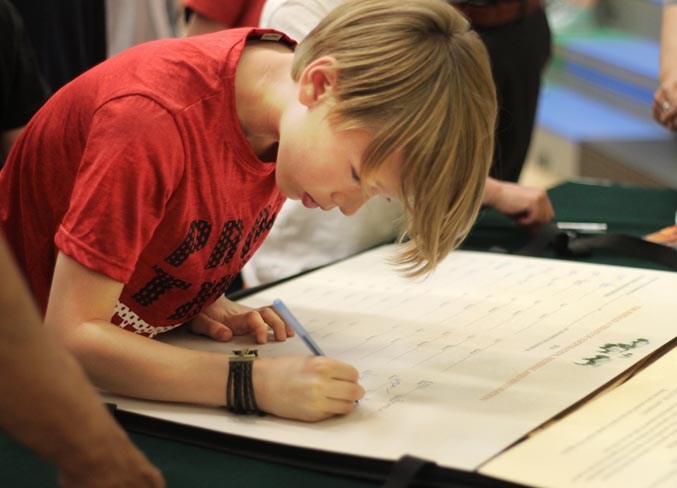A historic co-operation treaty in link with the return of the bison to Banff National Park was first signed by First Nations groups in 2014. This week, students at Glenbow Elementary School were able to sign in a Ceremony of Support to commemorate that important event. It began with the Grade 4s, who as part of their curriculum, were being taught about the progress towards returning bison to traditional lands. "We kind of looked at the buffalo and the bison as our lens and the symbolism of the buffalo being the ecological part, the historical part and cultural part," said Grade 4 teacher Cailin Morrison. When Blood Tribe elder Leroy Little Bear caught wind of the work the class was doing, he decided to hold a special talk at the school. "This is real life learning and for our students to really understand their history as Albertans and understanding the importance of our First Nations people." There are five articles in the 2014 Buffalo Treaty that people can participate in. Article V - based on education - is where the students signed their support. "The most important thing they should know is that buffalo is really a keystone species for the environment, there are certain animals that bring other animals into the picture and around which other animals build. It's kind of like a superstar in a hockey team," said Little Bear, a member of the Blood Tribe (Kainai), former professor at the University of Lethbridge and signatory of the Treaty. Little Bear shared with them the importance of the buffalo both ecologically and culturally. When construction of a road through the Blood Tribe reserve in southern Alberta began years ago, Littlebear recalled the workers being perplexed by the landscape. "The main surveyor was looking through his scope and he would step aside and ... then he would look through the scope again, step aside," Little Bear said. It wasn't what the surveyor saw with plain eyes, but rather through the scope. "Finally, he called his assistant, 'come over here, I want you to look through this scope.'" Little Bear said. "'what do you see?' he said when I look through the scope, I see thousands of buffalo out on the plains," Little Bear recounted. "Well those surveyors in turn were telling this story to our elders. Our elders were telling us in turn 'the buffalo may unfortunately be gone but the spirit of that buffalo is still here, it hasn't left us.'" Amythist First Rider also a Blood Tribe elder, joined Little Bear and told the students stories of animals coming to visit the buffalo that were placed in Banff National Park. "They remember their relationship with the buffalo and today and in the future you will all have a relationship with the buffalo," First Rider said. "You are part of the buffalo family ... Congratulations on becoming little buffaloes." she said.




